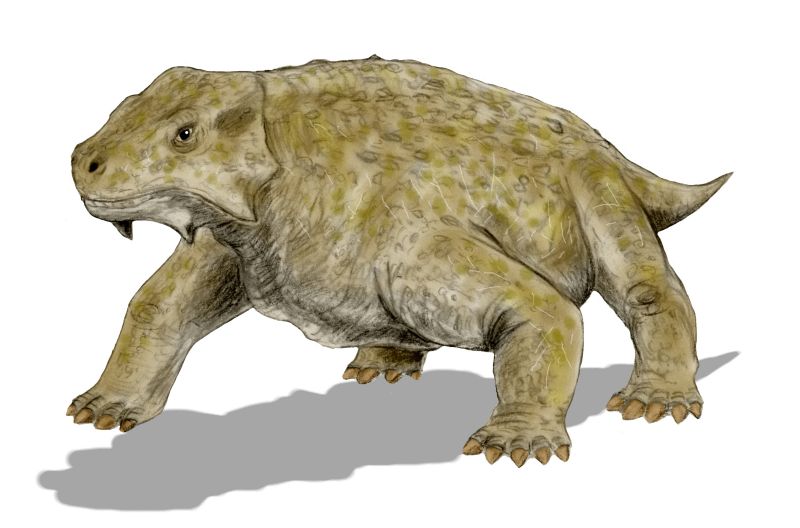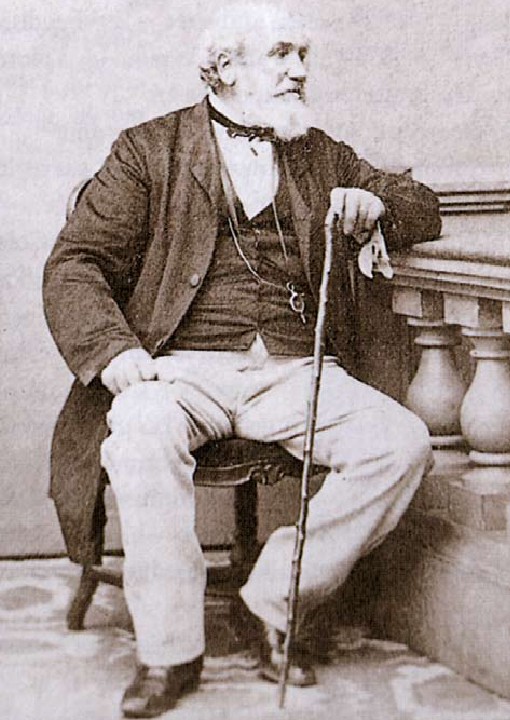|
Cynognathus Assemblage Zone
The ''Cynognathus'' Assemblage Zone is a tetrapod biozone utilized in the Karoo Basin of South Africa. It is equivalent to the Burgersdorp Formation, the youngest Lithostratigraphy, lithostratigraphic Geological formation, formation in the Beaufort Group, which is part of the fossiliferous and geologically important Karoo Supergroup. The ''Cynognathus'' Assemblage Zone is the youngest of the eight biozones found in the Beaufort Group, and is considered to be late Early Triassic (Olenekian) to early Middle Triassic (Anisian) in age (around 247 Ma). The name of the biozone refers to ''Cynognathus, Cynognathus crateronotus'', a large and carnivorous cynodont therapsid which occurs throughout the entire biozone. History The first fossils to be found in the Beaufort Group rocks that encompass the current eight biozones were discovered by Andrew Geddes Bain in 1856. However, it was not until 1892 that it was observed that the geological strata of the Beaufort Group could be different ... [...More Info...] [...Related Items...] OR: [Wikipedia] [Google] [Baidu] |
Early Triassic
The Early Triassic is the first of three epochs of the Triassic Period of the geologic timescale. It spans the time between 251.9 Ma and Ma (million years ago). Rocks from this epoch are collectively known as the Lower Triassic Series, which is a unit in chronostratigraphy. The Early Triassic is the oldest epoch of the Mesozoic Era. It is preceded by the Lopingian Epoch (late Permian, Paleozoic Era) and followed by the Middle Triassic Epoch. The Early Triassic is divided into the Induan and Olenekian ages. The Induan is subdivided into the Griesbachian and Dienerian subages and the Olenekian is subdivided into the Smithian and Spathian subages. The Lower Triassic series is coeval with the Scythian Stage, which is today not included in the official timescales but can be found in older literature. In Europe, most of the Lower Triassic is composed of Buntsandstein, a lithostratigraphic unit of continental red beds. The Early Triassic and partly also the Middle Trias ... [...More Info...] [...Related Items...] OR: [Wikipedia] [Google] [Baidu] |
Karoo Supergroup
The Karoo Supergroup is the most widespread stratigraphic unit in Africa south of the Kalahari Desert. The supergroup consists of a sequence of units, mostly of nonmarine origin, deposited between the Late Carboniferous and Early Jurassic, a period of about 120 million years. In southern Africa, rocks of the Karoo Supergroup cover almost two thirds of the present land surface, making part of the 75% of sediments or sedimentary rocks covering the earth including all of Lesotho, almost the whole of Free State, and large parts of the Eastern Cape, Northern Cape, Mpumalanga and KwaZulu-Natal Provinces of South Africa. Karoo supergroup outcrops are also found in Namibia, Eswatini, Zambia, Zimbabwe and Malawi, as well as on other continents that were part of Gondwana. The basins in which it was deposited formed during the formation and breakup of Pangea.McCarthy, T., Rubridge, B. (2005). ''The Story of Earth and Life.'' pp. 161, 187–241. Struik Publishers, Cape Town The type area o ... [...More Info...] [...Related Items...] OR: [Wikipedia] [Google] [Baidu] |
Endothiodon
''Endothiodon'' (/ɛndoʊθiːoʊdɔːn/ "inner tooth" from Greek endothi (ἔνδοθῐ), "within", and odon (ὀδών), "tooth", most likely named for the characteristic of the teeth being placed internally to the maxilla) is an extinct genus of medium to large dicynodont from the Late Permian. Like other dicynodonts, ''Endothiodon'' was an herbivore, but it typically lacked the two tusks that characterized most other dicynodonts and instead had long rows of teeth inset in the jaws that replaced in waves. The anterior portion of the upper and lower jaw are curved upward, creating a distinct beak that is thought to have allowed them to be specialized grazers.Latimer E. M., Gow C. E., Rubidge B. S. "Dentition and feeding niche of ''Endothiodon'' (Synapsida;Anomodontia)" Palaeontologia Africana 32, 75-82 (1995) ''Endothiodon'' was widespread and is found across the southern region of what was then a single large continent known as Pangea. It was originally only found in southern ... [...More Info...] [...Related Items...] OR: [Wikipedia] [Google] [Baidu] |
Pareiasaurus
''Pareiasaurus'' (from , "cheek" and , "lizard") is an extinct genus of Pareiasauromorpha, pareiasauromorph reptile from the Permian period. It was a typical member of its family (biology), family, the pareiasaurids, which take their name from this genus. Fossils have been found in the Beaufort Group. Description ''Pareiasaurus'' is a large quadruped, about long, with elephantine legs, walking in a typically reptilian posture. The skull is broad and the snout short. Its skull had several spine- and wart-like protrusions. ''Pareiasauruss leaf-shaped teeth, ideal for biting through tough plant fibers, indicate it was a herbivore. Even the palate had teeth. Species ''P. nasicornis'' (Haughton and Boonstra, 1929) is from the ''Tropidostoma'' Zone, Karoo basin, South Africa. This early form is one of the first representatives of the genus. It was originally included under the genus ''Pareiasuchus''. The snout is heavily armoured, and bears a horn-like boss. The teeth are equipped ... [...More Info...] [...Related Items...] OR: [Wikipedia] [Google] [Baidu] |
Theriodont
The theriodonts (clade Theriodontia) are a major group of therapsids which appeared during the Middle Permian and which includes the gorgonopsians and the eutheriodonts, itself including the therocephalians and the cynodonts. Naming In 1876, Richard Owen named a suborder Theriodontia, which he divided into the Cynodontia and the Gomphodontia. In 1956, D. M. S. Watson and Alfred Romer divided Therapsida into Theriodontia, which predominantly included carnivorous species, and the mostly herbivorous Anomodontia, defined as comprising Dinocephalia as well as Venyukovioidea and Dicynodontia. The modern clade concept was devised by James Allen Hopson. In his system, Theriodontia fall into two main groups: the Gorgonopsia and the Eutheriodontia. The latter consist of the Therocephalia and Cynodontia.J.A. Hopson. 1999. "Therapsids". ''Encyclopedia of Paleontology'' 2: 1256-1266 Evolution Theriodonts appeared at the same time as their sister group within the Neotherapsida, t ... [...More Info...] [...Related Items...] OR: [Wikipedia] [Google] [Baidu] |
Dicynodont
Dicynodontia is an extinct clade of anomodonts, an extinct type of non-mammalian therapsid. Dicynodonts were herbivores that typically bore a pair of tusks, hence their name, which means 'two dog tooth'. Members of the group possessed a horny, typically toothless beak, unique amongst all synapsids. Dicynodonts first appeared in Southern Pangaea during the mid-Permian, ca. 270–260 million years ago, and became globally distributed and the dominant herbivorous animals in the Late Permian, ca. 260–252 Mya. They were devastated by the end-Permian Extinction that wiped out most other therapsids ca. 252 Mya. They rebounded during the Triassic but died out towards the end of that period. They were the most successful and diverse of the non-mammalian therapsids, with over 80-90 genera known, varying from rat-sized burrowers to elephant-sized browsers. Characteristics The dicynodont skull is highly specialised, light but strong, with the synapsid temporal openings at the rear o ... [...More Info...] [...Related Items...] OR: [Wikipedia] [Google] [Baidu] |
Pareiasaur
Pareiasaurs (meaning "cheek lizards") are an extinct clade of large, herbivorous parareptiles. Members of the group were armoured with osteoderms which covered large areas of the body. They first appeared in southern Pangea during the Middle Permian, before becoming globally distributed during the Late Permian. Pareiasaurs were the largest reptiles of the Permian, some reaching sizes over , equivalent to the largest contemporary therapsids. Pareiasaurs became extinct in the end-Permian mass extinction event. Description Pareiasaurs ranged in size from long, with some species estimated to exceed in body mass. The limbs of many parieasaurs were extremely robust, likely to account for the increased stress on their limbs caused by their typically sprawling posture. The cow-sized '' Bunostegos'' differed from other pareiasaurs by having a more upright limb posture, being amongst the first amniotes to develop this trait. Pareiasaurs were protected by bony scutes called osteoderms ... [...More Info...] [...Related Items...] OR: [Wikipedia] [Google] [Baidu] |
Harry Seeley
Harry Govier Seeley (18 February 1839 – 8 January 1909) was a British paleontologist. Early life Seeley was born in London on 18 February 1839, the second son of Richard Hovill Seeley, a goldsmith, and his second wife Mary Govier. When his father was declared bankrupt, Seeley was sent to live with a family of piano makers. Between the ages of eleven and fourteen, he went to a day school and then spent the next two years learning to make pianos. He also attended lectures at the Royal School of Mines by Thomas Henry Huxley, Edward Forbes, and other notable scientists. In 1855, with the support of his uncle, Seeley began to study law but shortly gave it up to pursue a career as an actuary. In the late 1850s, he studied English and mathematics at the Working Men's College and served as a secretary for the college's museum. He also worked in the library of the British Museum, where Samuel Pickworth Woodward encouraged him to study geology. In 1859, Seeley began studies at Sidney ... [...More Info...] [...Related Items...] OR: [Wikipedia] [Google] [Baidu] |
Taxon
In biology, a taxon (back-formation from ''taxonomy''; : taxa) is a group of one or more populations of an organism or organisms seen by taxonomists to form a unit. Although neither is required, a taxon is usually known by a particular name and given a particular ranking, especially if and when it is accepted or becomes established. It is very common, however, for taxonomists to remain at odds over what belongs to a taxon and the criteria used for inclusion, especially in the context of rank-based (" Linnaean") nomenclature (much less so under phylogenetic nomenclature). If a taxon is given a formal scientific name, its use is then governed by one of the nomenclature codes specifying which scientific name is correct for a particular grouping. Initial attempts at classifying and ordering organisms (plants and animals) were presumably set forth in prehistoric times by hunter-gatherers, as suggested by the fairly sophisticated folk taxonomies. Much later, Aristotle, and later st ... [...More Info...] [...Related Items...] OR: [Wikipedia] [Google] [Baidu] |
Andrew Geddes Bain
Andrew Geddes Bain (baptised 11 June 1797 – 20 October 1864), was a Cape Colony geologist, road engineer, palaeontologist and explorer. Life history The only child of Alexander Bain and Jean Geddes, both of whom died when Bain was still a young boy, Bain was baptised 11 June 1797 in Thurso, Scotland. He was raised by an aunt who lived near Edinburgh. Here he received a classical education, but no vocational training. In 1816 he emigrated to Cape Town accompanied by his uncle Lieutenant Colonel William Geddes of the 83rd Regiment, who was stationed in the Cape. He married Maria Elizabeth von Backstrom on 16 November 1818 and had 3 sons and 7 daughters. In 1822 he bought property in Graaff Reinet and carried on for some years the business of a saddler. In 1825 he accompanied John Burner Biddulph on a trading expedition to Kuruman, the mission outpost on the edge of the Kalahari and home of Dr. Robert Moffat (father-in-law of David Livingstone). They explored further north a ... [...More Info...] [...Related Items...] OR: [Wikipedia] [Google] [Baidu] |
Fossil
A fossil (from Classical Latin , ) is any preserved remains, impression, or trace of any once-living thing from a past geological age. Examples include bones, shells, exoskeletons, stone imprints of animals or microbes, objects preserved in amber, hair, petrified wood and DNA remnants. The totality of fossils is known as the ''fossil record''. Though the fossil record is incomplete, numerous studies have demonstrated that there is enough information available to give a good understanding of the pattern of diversification of life on Earth. In addition, the record can predict and fill gaps such as the discovery of '' Tiktaalik'' in the arctic of Canada. Paleontology includes the study of fossils: their age, method of formation, and evolutionary significance. Specimens are sometimes considered to be fossils if they are over 10,000 years old. The oldest fossils are around 3.48 billion years to 4.1 billion years old. Early edition, published online before prin ... [...More Info...] [...Related Items...] OR: [Wikipedia] [Google] [Baidu] |









